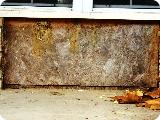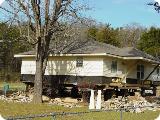Combating Repetitive Loss
Crawford County, AR – Recovering from continuous flooding was all too familiar to Joey Work and his family. The nightmares began in 2000, re-surfaced in 2002 and again in 2004. Each time, floodwaters from the Mulberry River inundated their home, destroyed their possessions, caused massive clean-up efforts and wreaked havoc in their lives while struggling to recover. Repetitive loss claims totaled an astounding $152,080.20.
On August 17, 2004, Joey Work, a Department of Transportation employee, received a letter from the floodplain administrator of Crawford County. Work’s home was declared substantially damaged (damage sustained by a structure whereby the cost of restoring the structure to its pre-disaster condition would equal or exceed 50 percent of the market value of the structure before the damage occurred). The 1380 square foot wood-frame home, valued at $64,383, required a repair cost of $45,758.
“My home was flooded twice in 2004, in April and again in August. I was told that I couldn’t live in the house unless it was elevated”, Work said. “Before this last event, I had gotten permission from the [U.S. Army] Corps of Engineers to raise the height of the little levee behind my house but that didn’t work. Water rose above the levee and got into my house.”
As a National Flood Insurance Program (NFIP) policyholder with a substantial damage claim, Work had to adhere to NFIP guidelines, including elevating his home at or above the Base Flood Elevation (BFE). The BFE is the computed elevation to which floodwater is anticipated to rise during the base flood and is also the regulatory requirement for the elevation or floodproofing of structures.
Dennis Gilscrap, the floodplain administrator, provided guidance throughout the elevation project. “I required him to get a surveyor. The BFE in his area is 420 feet. It was determined that his floor level was 418.8 feet,” Gilscrap said. A firm advocate of freeboarding, Gilscrap urged Work to elevate the home above the recommended BFE.
“As an extra precautionary measure I always advise folks to raise structures above the BFE. Of course it’s left up to the individual,” Gilscrap said. “Mr. Work elevated to 421.54 feet, which gave him a free board of about one and a half feet.”
The elevation project, which cost approximately $27,090 took a year to complete. Membership in the NFIP proved rewarding. In addition to building coverage, NFIP policyholders with substantially damaged homes are eligible for Increased Cost of Compliance (ICC) benefits. ICC coverage provides up to $30,000 to elevate, demolish, or relocate the home, protecting it from future flood damage. The coverage is included under all NFIP policies issued or renewed after June 1, 1997. ICC funds were used to defray the cost of the project.
In March 2008, the Mulberry River overtopped its banks. Floodwaters made a return visit to Work’s property. This time he was prepared.
“I was totally frustrated when I realized we were living in a flood zone. I have lived here for 15 years. The previous owner didn’t share that information,” Work said. “This time we were ready for the flood. Water got up into the yard only. The elevation project was worth it.”
Crawford County,
Arkansas



Quick Facts
Year:
2004
Sector:
Private
Cost:
$27,090.00 (Actual)
Primary Activity/Project:
Elevation, Structural
Primary Funding:
National Flood Insurance Program (NFIP)

